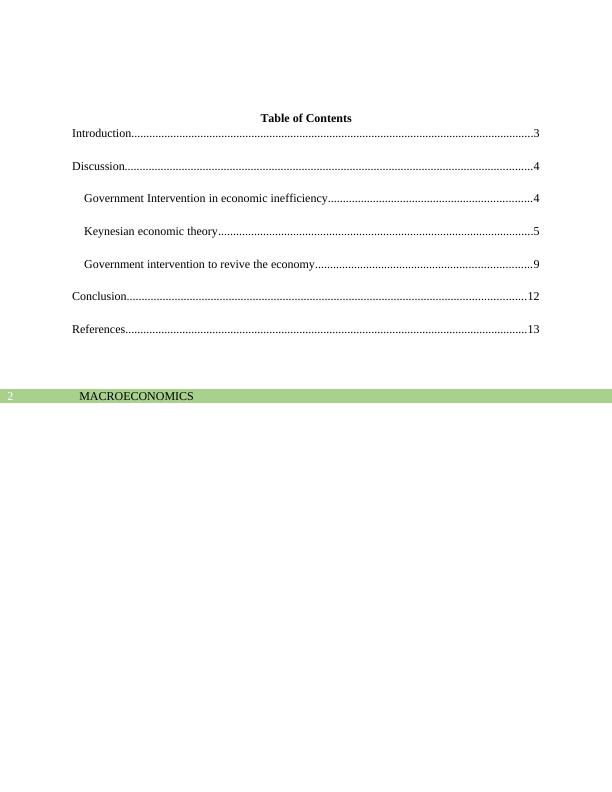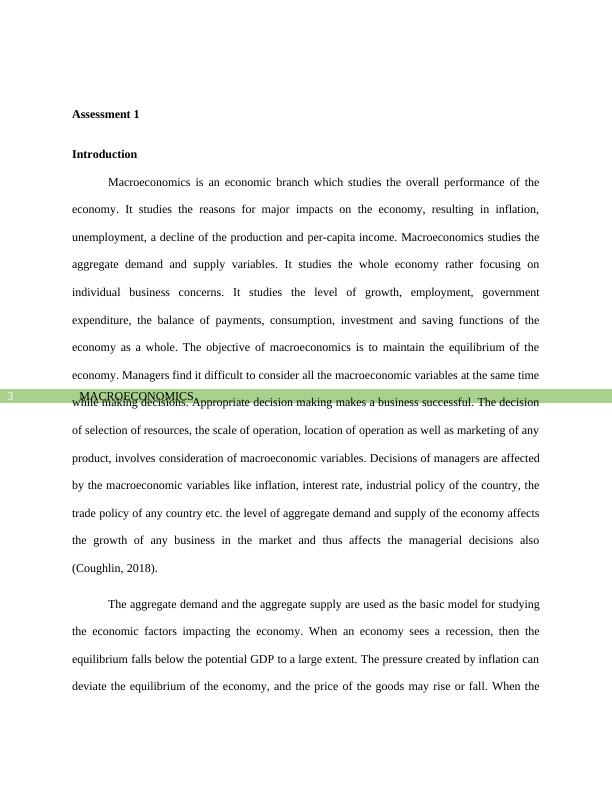Macroeconomic Factors and the Role of Government
Added on 2022-09-14
16 Pages3598 Words11 Views
Running head: MACROECONOMICS
MACROECONOMICS
Name of the student
Name of the university
Author’s note
MACROECONOMICS
Name of the student
Name of the university
Author’s note

MACROECONOMICS1
Executive summary
The project aims at studying the different macroeconomic factors and the role of government
intervention in the economy to bring the economy towards equilibrium. It takes example of
‘Australia’s recession’ during period of 2018 to 2019 to understand the role of government
intervention. It concludes that the fiscal and monetary policies are the crucial measures adopted
by the government and central bank to deal with the economic recession.
Executive summary
The project aims at studying the different macroeconomic factors and the role of government
intervention in the economy to bring the economy towards equilibrium. It takes example of
‘Australia’s recession’ during period of 2018 to 2019 to understand the role of government
intervention. It concludes that the fiscal and monetary policies are the crucial measures adopted
by the government and central bank to deal with the economic recession.

MACROECONOMICS2
Table of Contents
Introduction......................................................................................................................................3
Discussion........................................................................................................................................4
Government Intervention in economic inefficiency....................................................................4
Keynesian economic theory.........................................................................................................5
Government intervention to revive the economy........................................................................9
Conclusion.....................................................................................................................................12
References......................................................................................................................................13
Table of Contents
Introduction......................................................................................................................................3
Discussion........................................................................................................................................4
Government Intervention in economic inefficiency....................................................................4
Keynesian economic theory.........................................................................................................5
Government intervention to revive the economy........................................................................9
Conclusion.....................................................................................................................................12
References......................................................................................................................................13

MACROECONOMICS3
Assessment 1
Introduction
Macroeconomics is an economic branch which studies the overall performance of the
economy. It studies the reasons for major impacts on the economy, resulting in inflation,
unemployment, a decline of the production and per-capita income. Macroeconomics studies the
aggregate demand and supply variables. It studies the whole economy rather focusing on
individual business concerns. It studies the level of growth, employment, government
expenditure, the balance of payments, consumption, investment and saving functions of the
economy as a whole. The objective of macroeconomics is to maintain the equilibrium of the
economy. Managers find it difficult to consider all the macroeconomic variables at the same time
while making decisions. Appropriate decision making makes a business successful. The decision
of selection of resources, the scale of operation, location of operation as well as marketing of any
product, involves consideration of macroeconomic variables. Decisions of managers are affected
by the macroeconomic variables like inflation, interest rate, industrial policy of the country, the
trade policy of any country etc. the level of aggregate demand and supply of the economy affects
the growth of any business in the market and thus affects the managerial decisions also
(Coughlin, 2018).
The aggregate demand and the aggregate supply are used as the basic model for studying
the economic factors impacting the economy. When an economy sees a recession, then the
equilibrium falls below the potential GDP to a large extent. The pressure created by inflation can
deviate the equilibrium of the economy, and the price of the goods may rise or fall. When the
Assessment 1
Introduction
Macroeconomics is an economic branch which studies the overall performance of the
economy. It studies the reasons for major impacts on the economy, resulting in inflation,
unemployment, a decline of the production and per-capita income. Macroeconomics studies the
aggregate demand and supply variables. It studies the whole economy rather focusing on
individual business concerns. It studies the level of growth, employment, government
expenditure, the balance of payments, consumption, investment and saving functions of the
economy as a whole. The objective of macroeconomics is to maintain the equilibrium of the
economy. Managers find it difficult to consider all the macroeconomic variables at the same time
while making decisions. Appropriate decision making makes a business successful. The decision
of selection of resources, the scale of operation, location of operation as well as marketing of any
product, involves consideration of macroeconomic variables. Decisions of managers are affected
by the macroeconomic variables like inflation, interest rate, industrial policy of the country, the
trade policy of any country etc. the level of aggregate demand and supply of the economy affects
the growth of any business in the market and thus affects the managerial decisions also
(Coughlin, 2018).
The aggregate demand and the aggregate supply are used as the basic model for studying
the economic factors impacting the economy. When an economy sees a recession, then the
equilibrium falls below the potential GDP to a large extent. The pressure created by inflation can
deviate the equilibrium of the economy, and the price of the goods may rise or fall. When the

End of preview
Want to access all the pages? Upload your documents or become a member.
Related Documents
Economic Stability in Australialg...
|11
|1432
|427
Report on Stable Equilibrium in the Economylg...
|9
|1332
|42
Economics of Public Policy PDFlg...
|9
|2098
|52
Economics Assignment on Stable Equilibriumlg...
|12
|1531
|134
Stable Economic Equilibriumlg...
|9
|1482
|263
Global Macroeconomic Policy: Examining Policy Responses to Rising Oil Prices and Booming Stock Marketslg...
|9
|2563
|112
